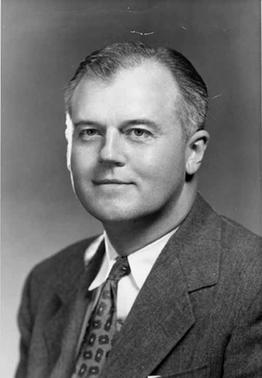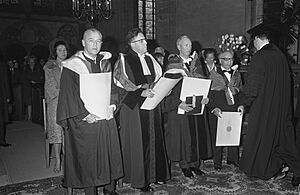Robert J. Van de Graaff facts for kids
Quick facts for kids
Robert J. Van de Graaff
|
|
|---|---|
 |
|
| Born |
Robert Jemison Van de Graaff
December 20, 1901 Tuscaloosa, Alabama, U.S.
|
| Died | January 16, 1967 (aged 65) Boston, Massachusetts, U.S.
|
| Nationality | American |
| Citizenship | American Citizen |
| Alma mater | University of Alabama (B.S.; M.S.) La Sorbonne University of Oxford (B.S.; D.Phil.) |
| Known for | Van de Graaff generator |
| Awards | Elliott Cresson Medal (1936) Duddell Medal and Prize (1947) Tom W. Bonner Prize in Nuclear Physics (1966) |
| Scientific career | |
| Fields | Physics |
| Institutions | Massachusetts Institute of Technology Princeton University |
| Doctoral advisor | John Sealy Townsend |
Robert Jemison Van de Graaff (born December 20, 1901 – died January 16, 1967) was an American physicist. He is famous for creating and building Van de Graaff generators, which are machines that make very high voltages. He spent most of his career working at the Massachusetts Institute of Technology (MIT).
Contents
Who Was Robert Van de Graaff?
Robert Jemison Van de Graaff was born in Tuscaloosa, Alabama. His father, Adrian, was a judge. Robert had three older brothers who were all famous college football players for the University of Alabama.
His Early Life and Education
Robert studied at the University of Alabama. He earned a degree in mathematics in 1922 and another in mechanical engineering in 1923. After working for a power company for a year, he went to France. In 1925, he attended lectures at the Sorbonne.
He then went to Oxford University in England on a special scholarship called a Rhodes Scholarship. There, he earned another degree and completed his Ph.D. in 1928. His advisor was a scientist named John Sealy Townsend.
Building High-Voltage Machines
Robert Van de Graaff is best known for inventing the Van de Graaff generator. This machine creates very high voltages of electricity. In 1929, he built his first generator, which could produce 80,000 volts. Just four years later, in 1933, he built a much larger one that could make 7 million volts!
From 1929 to 1931, Van de Graaff worked at Princeton University. Then, he moved to the Massachusetts Institute of Technology (MIT) in 1931. He became a professor there in 1934 and stayed until 1960. He received the Elliott Cresson Medal in 1936 for his work.
Work During and After World War II
During World War II, Robert Van de Graaff led a project that used high voltage for X-rays. After the war, he helped start a company called High Voltage Engineering Corporation (HVEC). He continued to invent new things, like a special transformer that made high-voltage direct current. He also improved his generators to make them even more powerful.
In 1965, the American Physical Society gave him the T. Bonner prize. This award was for his work on electrostatic accelerators, which are machines that speed up tiny particles using electricity.
Robert Van de Graaff passed away on January 16, 1967, in Boston, Massachusetts. A crater on the far side of the Moon is named after him to honor his contributions to science.
How a Van de Graaff Generator Works
A Van de Graaff generator uses a moving belt, usually made of rubber, to collect electric charges. This belt moves charges from one end to a large metal sphere at the other end. Because electric charge stays on the outside of the sphere, it builds up to create a much higher voltage.
Large Van de Graaff generators can produce about 7 million volts. They are mainly used as power sources for particle accelerators. These accelerators help scientists study tiny particles in nuclear physics experiments. Some generators, called "tandem" generators, are like two generators working together. They can create even higher voltages, up to about 15 million volts.
Demonstrating Electricity
The Van de Graaff generator is a simple machine. Many people, including hobbyists and science companies, build smaller versions. These are great for showing how high-voltage electricity works. Even small machines can create impressive sparks that are several centimeters long!
The biggest Van de Graaff generator in the world that uses air for insulation was built by Van de Graaff himself. You can see it working at the Boston Museum of Science. Live demonstrations are a popular attraction there.
Newer Van de Graaff generators use special gases, like freon, instead of air for better insulation. While Van de Graaff generators were once very important, newer particle accelerators use different technologies to create even higher energies. However, these generators are still used in some universities for research and as sources for bursts of ions.
Patents
- US1,991,236 – "Electrostatic Generator"
- US2,024,957 – "Electrical Transmission System"
- US3,187,208 – "High Voltage Electromagnetic Apparatus Having An Insulating Magnetic Core"
- US3,323,069 – "High Voltage Electromagnetic Charged-Particle Accelerator Apparatus Having An Insulating Magnetic Core"
- US3,308,323 – "Inclined field High Voltage Vacuum Tubes"
See also
 In Spanish: Robert J. van de Graaff para niños
In Spanish: Robert J. van de Graaff para niños


